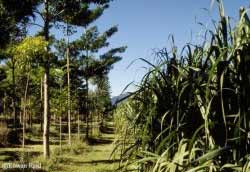|
|
|
Evaluating a farm forestry project

Good design is essential to developing
a farm forestry project plan that is consistent with a farmer’s
needs, constraints and opportunities, and is both profitable
and appropriate. A useful starting point is for farmers to
try and visualise what their perfect forest might look like.
This provides a focus for deciding on tree species, layout
and management. It also helps identify risks and uncertainties.
Farmers should use the experience in their region, and make
notes on the advantages and disadvantages of each of these,
to evaluate different options.
Economists generally use a discounted cash flow analysis to
calculate a Net Present Value (NPV $/ha) to test and compare
the viability of different investments. Before accepting the
outcome of such analysis, farmers need to be sure that the
criteria used, and the assumptions on which they are based,
are relevant to their particular circumstances. For example,
the predicted Net Present Value per hectare of land is often
used to decide whether a particular forestry venture is appropriate.
For farmers who have plenty of land requiring revegetation,
but are constrained by the costs involved, it might be more
appropriate to use different criteria to compare options.
For example, NPV per dollar invested or NPV per hour spent
working in the forest might be a more suitable performance
criteria.
In many cases the decision to plant trees is based solely
on the potential to achieve non-timber benefits such as shelter
for stock, rat control (in sugar cane) or land degradation
control. On some farms there is also potential to obtain a
commercial return by incorporating commercial tree species
and managing them for timber or other commercial products.
Farmers need to decide if it is worth investing additional
time or money to keep open the option of a commercial return.
In some cases it is impossible to use a dollar figure for
a farmer's personal performance criteria. The value of enhancing
a farm’s attractiveness or amenity is irrelevant if the
farmer has no intention of selling it. Farmers for whom landscape
is an important consideration should try and visualise how
the forest will look as it grows and then describe their likes
and dislikes. There are computer models that can help do this.
But the best starting point is for farmers to visit local
farms where other farmers are doing similar things and make
their own judgment about the appropriateness of different
options.
By referring back to their original goals and constraints,
farmers can make a final decision with which they are comfortable,
supported by economic analysis, risk assessment and personal
preferences. It is important for farmers to remember that
what is appropriate for others, even their neighbours, will
not necessarily be appropriate for them. They should not proceed
with a farm forestry project if developing a practical and
attractive design, that involves an acceptable level of risk,
seems impossible. Farmers should instead keep an eye open
for new opportunities or changing circumstances. Farm forestry
is a dynamic industry with new methods and markets continually
being developed.
Economics of
farm forestry
Back to top
|
